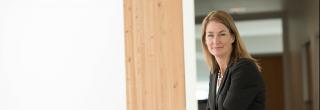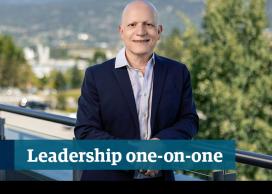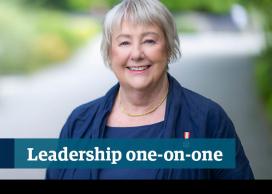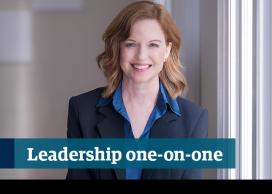Karyn Magnusson is the Managing Director of Building Operations at UBC Vancouver.
A UBC alumna, Karyn is a registered professional engineer, and spent 14 years within progressive leadership roles with the City of Vancouver’s engineering department. She joined UBC in 2014 to lead the operations and maintenance of over nine million square feet of building space and over 1,000 acres of landscaping at UBC Vancouver’s Point Grey campus. She is a former elite-level swimmer.
Q1. What quality do you most admire in a leader?
KM: Aside from the obvious qualities, like being able to inspire and clearly communicate a vision, I think what I admire most in a leader is authenticity. From authenticity comes the ability to develop trust. When I look at our workforce and how large it is (there are more than 700 staff in Building Operations), I believe that if we don’t have trust in one another, we are really not able to step up to do our best.
Q2. What makes you laugh?
KM: My kids. They are at that really cool age (7 and 9) where they have no filters, no boundaries, and just express whatever comes to mind. So, I might walk in on them air guitaring and think they will get self-conscious and stop, but no… They keep rocking out. They allow me to shake off some formality and just have fun.
Q3. Who inspires you, and why?
KM: It’s a quality of people that inspires me. I am in awe of people who push boundaries, like mountaineers and inventors… people who are able to make a life out of their passions, and have the incredible focus to actually reach previously unobtainable goals. I am in awe of those people. I find them very inspiring and very humbling.
Q4. If you could have a super power, what would it be?
KM: I am a bit of a procrastinator, so I’d like to freeze time, so that I could try to accomplish some of the goals I have in life! I’d also like to be able to see through walls. On this campus, there are so many hidden issues, that fortunately our team is able to diagnose and troubleshoot. But if I could see through walls, we’d be able to get to the solutions so much quicker!
Q5. What does the work of Building Operations involve?
KM: Our workforce includes teams of custodial staff who keep the interior spaces clean; skilled tradespeople who can fix and repair almost anything on this campus; municipal staff who take care of outdoor public realm spaces and waste, recycling and organics collection; and a customer service team who make sure we understand what the needs of the campus are, so that we can be really proactive in anticipating issues before they happen. When our teams do their best work, we maintain spaces that support exceptional research and create wonderful student experiences. My Building Operations colleagues are silent heroes… When we do our job well, nobody sees us!
Q6. What’s your biggest accomplishment so far at UBC?
KM: I’m proud of my ability to engage the workforce and build a strong sense of team. I believe in identifying and addressing the barriers that exist in order to bring out the best in people, in providing them with the tools and direction they need to do a good job, in holding them accountable and celebrating their successes. I think we’ve built a team that supports that vision and are seeing some really positive changes in our workforce.
Q7. What’s the most important lesson you’ve learned?
KM: You need to go slow to go fast. When you’re a new person in a new organization, you have to really take the time to listen to people. I learned that you can’t make changes based on your assumptions or perceptions. If you take the time to listen to people’s ideas, and get their input, you’re going to get much better buy-in and much better adherence to a new way of doing things, and thus much better results in the long run.
Q8. How do you like to recharge?
KM: Going skiing. I spend pretty much every spare moment in the mountains. My kids are finally getting into it as well, so it is something we can do as a family. When I’m on my skis, I feel 23 again, which is very recharging.
Q9. For you, what makes UBC different?
KM: What makes UBC really different and special to me is the connection that every person on this campus has to the higher goal of making the world a better place. I know that may sound really cliché, but it actually is true. When I walk around and see the calibre of students, faculty and staff here, and know that our team contributes to creating spaces that make those individuals be at their best, I’m so inspired! Knowing the kind of work that happens here makes it the kind of place I want to commit a lot of my effort and time to.
I also have a really cool connection to UBC that dates further back than when I studied here. My grandfather was UBC’s head carpenter in the 1960s. That era was really special because it was when the university commissioned Bill Reid to do the totems that now stand at the Museum of Anthropology (MOA). Bill taught my grandfather how to carve wood using traditional methods, and so our family has all these wonderful carvings that my grandfather did, that reflect this connection to his UBC days. You may notice that the backs of the carvings at MOA are all flat… The wood that was stripped off the backs built the doors at my father’s house. So, I have grown up with a bit of UBC’s campus.
Q10. What is the best advice you were ever given?
KM: It was advice my husband gave me back in the 1990s: “Come to the disc.” He was talking about Ultimate Frisbee (which he and I used to play together), but I think it’s a really interesting metaphor for life. When you’re playing Ultimate, you don’t just wait for someone to pass you the Frisbee — you shorten the distance of the pass by running to it. I think in life you need to honour the effort that people are putting in, so if they are going to give you something, you shouldn’t wait for it to be handed to you, but rather meet them half way. It’s a great piece of advice to live your life by.
Q11. What do you value in your colleagues?
KM: I really value the skills and unique experiences that everyone brings. I started my career as an engineer on mining construction sites, and that was a really unusual place for a young woman to be. I learned very early that you need to value peoples’ experience and skills. Playing the power of your position doesn’t get you anywhere. And so, I value teammates who share that approach and recognize that there isn’t a hierarchy of team, but rather, a diversity of skills. There is a place for everybody and an importance of everybody. You have to play to peoples’ strength, skills and experiences. Sometimes people think that if you’re the senior manager in an organization, you need to know everything and be right about everything. What you really need to know is how to play to your team. You need to know what their strengths are, what their blind spots are, help remove barriers, provide tools and direction and support them. And then you need to back off and let them do their work.
Q12. What would you like to be remembered for?
KM: I would like to be remembered for pushing for change when it’s the right thing to do. I am someone who is not afraid to tackle issues of injustice or inequity or unfairness, as I believe there is always an opportunity for improvement.
Q13. How does your experience as an elite-level swimmer inform your life?
KM: Swimming at the international level was a really informative part of my life. I started competing at 9, and — as well as time management — learned to be realistic with goals and making sure I assigned the right amount of effort needed to achieving them.
Q14. How important do you feel it is to support women in leadership?
KM: I think it is important to support everyone in leadership. I do of course acknowledge that there are traditional biases that have prevented diversity in leadership ranks. But rather than supporting particular demographics or groups, I prefer to focus on removing the barriers that create the inequity.
In Building Operations, we do a number of things very deliberately to try to remove the barriers for entry and promotion that traditionally may have existed. For example, we go out of our way to attract a diverse range of staff, so that we are always able to capture the top talent. We provide acting opportunities, so that a variety of staff can equitably get access to leadership experiences, and so when there is a permanent posting, the playing field is a lot more level.
Published: July 1, 2017
Interviewed by: Megan Czerpak, UBC Internal Communications



